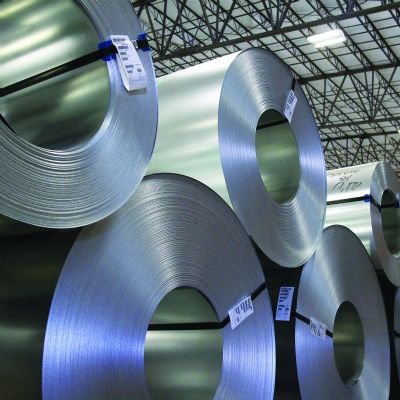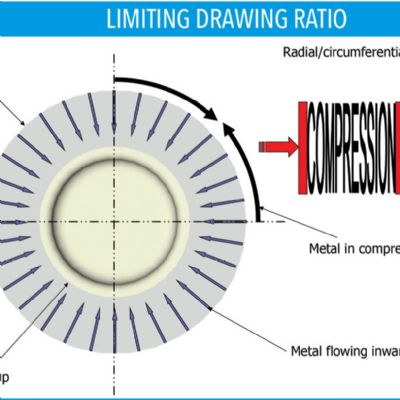Customers needed to determine the impact of using non-complying materials. Even if Kobe officials were aware of the affected shipments and customers, it still faced challenges when trying to trace the substandard products used to assemble specific planes, trains and automobiles. In the automotive-assembly process, for example, while we typically see good traceability through the stamping process, once stamped panels ship to the subassembly workstation, complexity and scheduling constraints make it difficult to trace specific coil numbers to assembled products.
Random spot checks of assembled vehicles prove impractical and would not yield useful information. The stamping process changes the tensile properties of the sheet metal, making it impossible to say after the fact that the incoming properties were noncompliant. Further, running a tensile test on a part already on a vehicle requires cutting into an otherwise sellable car or truck. It might be possible to use a noncontact probe such as an x-ray fluorescence gauge to determine the composition of the material, but at best that only would verify that the right alloy was used—think mild steel vs. high-strength steel, or 5XXX aluminum vs. 6XXX aluminum. Alloys have a wide range of acceptable composition values, and it is impossible to know the impact on resultant tensile properties without knowing the full mill-processing history. In addition, the volumes associated with the automobile industry make this a needle-in-the-haystack effort; top-selling vehicles exit the assembly line every minute.
For these reasons, Kobe’s customers were forced to assess the implications of using substandard metal products. It supplied aluminum to Toyota, Honda and Mazda for use on hoods. Each automaker stated that it did not have any safety-related concerns, possibly because hoods typically are not designed as structural members. Other customers went through similar, thorough assessments to determine their risk. For example, JR Central had to replace 1100 aluminum parts on its bullet trains after determining that their strength was critical to their function.
In the aftermath, a Tokyo court ordered Kobe to pay an $898,000 fine for falsifying product-quality data. Further, at one of its plants, Japanese Industrial Standards certifications (similar to ISO 9000) were suspended for 3 yr. due to problems found in its quality-management system.
Beyond these actions, the company’s reputation took a big hit, prompting a detailed investigation to identify the widespread problems and recommend corrective actions. The report’s conclusion: A focus on profits led the plants to take on business for which they were not capable of meeting all customer requirements. When issues occurred, corrective actions did not persist. Inadequate management discipline doomed the centralized control of the corporate-wide quality-assurance program.
Falsification was at least partially facilitated by the lack of automation in the creation of inspection documents, where test results were written down by hand and adjusted prior to entering them into the computer systems.
Substandard Castings in Navy Submarines
Bradken Inc, a subsidiary of Hitachi Construction Machinery, supplies the U.S. Navy with high-yield-strength steel designed to be tough enough to withstand extreme conditions, such as a submarine collision. During a three-decade period ending in 2017, the firm’s director of metallurgy falsified material-test results.
Once management became aware of the fraud, the Navy needed to undergo an extensive and costly analysis of the submarines that received the substandard parts, and ultimately mitigated all associated risk. As part of a $10.9-million settlement with the U.S. Justice Department, Bradken was required to improve its quality system and procedures and had to document its missteps in a trade publication, explaining how its systems failed to detect the fraud.
The fraud involved more than 200 batches of steel, representing a substantial percentage of the castings that Bradken produced for submarines built by Electric Boat Company and Newport News Shipbuilding. Although it did not disclose the specific application, the castings were used in critical components of submarines, with failure resulting in catastrophic damage.
The fraud involved at least two grades of quenched-and-tempered steels, HY-80 and HY-100 (80- and 100-ksi minimum yield strength, respectively). Bradken falsely represented a substantial percentage of castings made from these two grades as meeting standards. To make matters worse, after discovering the falsified data in 2017, Bradken management misled the Navy about the scope and nature of the fraud.
The data falsification at Bradken mirrored how some children attempt to falsify their report cards. Lab personnel would write tensile-test and Charpy V-notch impact test results on notecards and send them to the lead metallurgist for review. However, on grades requiring a minimum 80-ksi yield strength, for example, if tensile strength registered between 70 and 79 ksi, the lead metallurgist would take the handwritten notecard and change the first digit from 7 to 8. Then, she would enter the correct (failing) results into the internal database but enter the falsified (passing) results into the system used to generate the documents to certify that the casting met specification.
The issue finally came to light when a new metallurgist joined the team, taking over for the senior metallurgist as she transitioned to retirement. As part of a routine audit by the prime contractor, Bradken’s new metallurgist discovered discrepancies between the test results recorded in the internal system and those used for product certification. He elevated the issue to senior management, which confronted the senior metallurgist, who admitted that the results in question were far from an isolated incident. Her rationale: Because other test results registered well within specifications, the results in question must have been generated by mistake. Rather than retesting or correcting the perceived test-equipment issue, she simply falsified the results. MF
See also: Engineering Quality Solutions, Inc., 4M Partners, LLC
Technologies: Materials








 Webinar
Webinar
